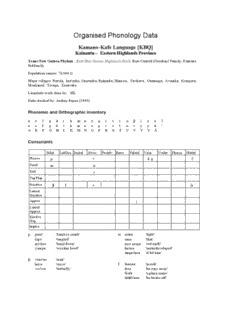Table Of ContentOrganised Phonology Data
Kamano-Kafe Language [KBQ]
Kainantu – Eastern Highlands Province
Trans New Guinea Phylum ; East New Guinea Highlands Stock; East-Central (Gorokan) Family; Kamano
Subfamily
Population census: 70,000 ()
Major villages: Barola, Ina'onka, Onerunka, Raipinka, Mamori, Tirokave, Onamuga, Avainka, Kompere,
Menkanof, Tevega, Kesävako
Linguistic work done by: SIL
Data checked by: Audrey Payne (1994)
Phonemic and Orthographic Inventory
e f h i k m n o p r s t u j z
a e f g h i k m n o p r s t u v y y ä '
A E F G H I K M N O P R S T U V Y Y Ä
Consonants
Bilab LabDen Dental Alveo Postalv Retro Palatal Velar Uvular Pharyn Glottal
Plosive p t k
Nasal m n
Trill r
Tap/Flap
Fricative f s h
Lateral
Fricative
Approx j
Lateral
Approx
Ejective
Stop
Implos
p pasa' 'bamboo comb' m mäsa 'light'
kipo 'tangled' ama 'that'
pri huo 'bend down' mro mopa 'red earth'
yompa 'wooden bowl' hu'ma 'underdeveloped'
ämpri'nea 'it bit him'
vene'ne 'man'
have 'stove' f fenone 'goods'
vre'vre 'butterfly' frea 'he runs away'
Kafe 'a place name'
ätäfri'nea 'he broke off'
Kamano-Kafe OPD Printed: August 24, 2004 Page 2
t tina 'water' -
ita 'table' ägona 'nose'
trame 'mother and child' hru 'body lice'
nämenta 'good' tänägra 'you two'
r ra 'big' -
kora 'blood' ha'o 'it is finished'
kra 'dog' yäho' 'wind'
käsro' nähee 'weary' vu'nee 'he went'
n nona 'house' h hinäma 'flea'
tina 'water' nehue 'I am doing'
ägahri 'eel'
vu'nee 'he went' hro 'pandanus leaf'
varenkra änte'nee 'swept'
j ya'u 'sweet potato'
s sasume 'axe' kuya 'python'
srifi 'a nose decoration' -
äsana 'arm band' eri'ya 'work'
käsro' nähee 'weary'
k keya tio 'call'
hake 'pitpit'
kruna 'a lie'
änanke 'his throat'
Vowels
i u
e o
i ifo 'deaf' ävuräga 'his eyes'
hiro 'good' mänani 'cassowary'
aki 'tomorrow' -
nämio 'give it to me'
tunai 'adze'
o ofu 'star'
noya' 'fish'
e efe' 'cockatoo' äso 'plant'
meni 'today' oe 'I come'
hake 'pitpit' e'neo 'has he come?'
vu'neo 'has he gone?'
nevie 'he goes'
u umpe'umpe 'mosquito'
muna'ne 'girl'
afi 'here' nämu 'sore'
amafi 'here' vue 'I go'
akru'a 'bark, skin' au hu'nee 'trouble'
tunai 'adze'
nenea 'he eats'
Kamano-Kafe OPD Printed: August 24, 2004 Page 3
Suprasegmentals (tone, stress, length)
Stress is phonemic, but is not written. Examples:
kaná 'heavy' kána 'road'
Tone is predictable by stress. The stressed syllable is either mid or high tone.
Syllable Patterns
V o 'yes' ä.tro 'leave, drop' e.tu.e.pa 'beetle sp.' tä.hu'.ne.a 'she cooked'
VC än.ti.vi corn'um.pe 'um.pe 'mosquito'
CV no 'eat!' ko.no' ‘cucumber' ki.rä.gi.o 'pour the water!' ha.'o 'that is finished'
CVC ku' 'string bag' kam.pra.ku ke.na 'bark skirt' nä.men.ta 'good' yä.ho' 'wind'
CCV kra 'dog' fra vä.yi.'ne.e 'he quarrelled'kam.pra.ku ke.na 'bark skirt'
sri.sri hu.'n.e.e 'hiss'
CCVC hru' 'body lice'
Conventions: Phonological
T glottal plosive [] is the only consonant that occurs word finally.
// can weaken to [ ] in word medial position.
/p/, /t/ and /k/ occur word medially only when preceded by a nasal or glottal.
Conventions: Orthographic
The glottal plosive [] is written < ' >, in older orthography it was written <q>
/z/ is interpreted either a phoneme or an allophone of /j/, and is written <y>.
Transcription of a recorded passage
/ m se nermi nkekee
hnki m sermiet n mofo jmpinti me hut nonone hnki mninej hoj ntej
fur krij jmritem jom henj her jmiteet hnki nojimifin mrerit jn
hnt hutet korom hutm rufim nemniretir mopin nemnit jmpintir nenet m
opina nemsone nemset trotet hoj enerit nemnit mofre nentone /
< A'ma äse nerämia näke'kee
Hanki ä'ma äserämigeta äna a'mofo äyampinti' äme huta nonone. Hanki mäni'ne'ya hoya änte'ya äfura kri'ya
yämägrite'ma yägoma häge'naya vähera yämitegeta hanki noyimifina mrerita äyana häntäga huteta koro'ma
hutama rufima nemäniretira mägopina nemänita äyampintira neneta mägopina nemäsone. Nemäseta tägroteta
hoya enerita nemänita mofrave nentone. >
When they buy us wifes
When they buy us a wife we do not quickly eat from their hands. The wives live there, start a garden, a herd of
pigs, and they give food to our relations who have bought them, then later we go to live in our wife's house and
eat food from their hands. We sleep together, garden and have children.
Kamano-Kafe OPD Printed: August 24, 2004 Page 4
Mark 2:1-
1. Yisasi'a rukrähe' huno' Kapanea kumate' ete neeno' nompi umäni 'nege'ya vea'mo'ya äntähi'naye.
2. Nentähi'ya maka'mo'ya ätru nehäyageno' nompine kasante'ene mäni titipa nehäyageno' monora
yämäsämi'nee.
3. Monora neyämäsämige'ya mägo'amo'ya ägia säti'nea ne' ävre'ya e'naye. Taregi' taregi' vähe'mo'ya yafa hu'ya
e'naye.
4. Yisasinte' neageno' hakare vähe'mo'ya mäni titipa häyage'ya Yisasinte' no hofa eri hägite'ne'ya äna ne'mo'
sesenkure' mäse'nege'ya ätrageno' urämi'nee.
5. Tämigeno' Yisasi'a ävre'ya e'namokiyimi yämägu'a yämentinti hu'naya ya negeno' äga säti'nea nera amänage
huno' äsämi'nee: Mofrave'nimoka kefoyanka'a eri ätregäntoe, huno' hu'nee.>
1.When he returned to Capernaum some time later, word went around that he was back;
2. and so many people collected that there was no room left, even in front of the door. He was preaching the
word to them
3. when some people came bringing him a paralytic carried by four men.
4. but as the crowd made it impossible to get the man to him, they stripped the roof over the place where Jesus
was; and when they had made an opening, they lowered the stretcher on which the paralytic lay.
5. Seeing their faith, Jesus said to the paralytic, "My child, your sins are forgiven."
Bibliography
Payne, A.M., and D.E. Drew. 1961. 'Kamano Phonemic Statement.' in 'Workshop Papers of the Summer
Institute of Linguistics New Guinea Branch, 1961' (unpublished).
Young, Rosemary. 1962. 'The Phonemes of Kanite, Kamano, Benabena and Gahuku.' Studies in New Guinea
Lingustics. Oceania Linguistic Monographs 6:90-110.
Drew, D., D. James, and A. Payne. 1963-1970. Manuscripts. SIL. Ukarumpa.

